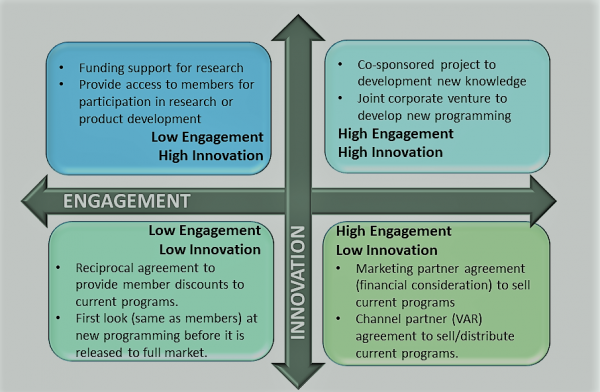Hitch Your Wagon to a Star—Find the Right Partner for Success

A comment Adele Cehrs, CEO and Founder of When + How agency, made stayed with me. Adele, who thrives on a healthy dose of risk, said this, “Chutzpah is what drives me and other entrepreneurs to keep reinventing ourselves. If you could bottle that it would be a wise idea for association CEOs to take a long drink.”
Today, even mild-mannered leaders have indulged in a shot, or two, of Chutzpah. And many are wondering how they can revive, reinvent, or grow their associations. Partnership is an evolving strategy that maximizes resources and expands relationships.
From mergers and acquisitions to joint meetings, .orgSource is often asked to evaluate collaborations. Sharon Rice, Managing Director of Business Strategy, is our expert in weighing the risk/benefits, examining the details, and guiding associations to successful results. If you are considering a collaboration, and want to hitch your wagon to a star, her advice will help you make that match.
“Associations have always formed partnerships,” Sharon noted. “At the beginning of my career, they were typically simple reciprocal transactions. An organization would sell its mailing list or develop an affinity program with an insurance or credit card company. Over the years, the arrangements have grown more complex.
“Associations are seeking to better serve members by partnering with technology, education, or content providers. The vendor receives exposure, and the association can deliver services that would otherwise be unavailable. HealthStream, a company that offers an array of credentialing and professional development products to medical organizations, is an example of the type of industry that has recently surfaced.”
Evaluate Impact

In a digital marketplace characterized by competition and disruption, to survive and grow associations may need to establish more sophisticated relationships. Sharon believes that strategic partnerships to open new markets and transform business models will become increasingly common.
Daniel A. Varroney, President and CEO of Potomac Core, predicts that we are in an unprecedented time when industries and their trade associations will form strategic partnerships that bring their supply chains together to identify challenges and build solutions.
What makes a strategic partnership different from more casual collaborations? Strategy is the operative word. According to McKinley Advisors, these are defining characteristics:
- Mutually beneficial arrangements
- Longer-term initiatives that span departments and activities and create lasting value for both groups
- Programs that advance organizations toward their strategic goals
Not to be mistaken for:
- One-sided agreements
- Transactional relationships that offer limited impact
- One-time events
Strategic partnerships can deliver:
- Significant opportunities for sharing important messages about your industry
- Increased brand exposure for collaborators
- New audiences
- Expanded human and financial resources
- Opportunities for thought leadership
“Strategic partnerships are, above all, transformative,” Sharon observes. “When they occur, they are phenomenal life and game-changing alliances that impact the profession and the industry. Because these collaborations demand significant effort and commitment, the majority of association relationships won’t fall into this category.
“To help clients assess the impact of a potential partnership, I use a matrix. The vertical axis represents the possibility for innovation and the horizontal axis indicates the level of engagement/effort required. Different kinds of collaborations are defined by each quadrant, with the lower left and upper right representing opposite ends of the scale.”
High Innovation/High Engagement

“As the most impactful, strategic partnerships are characterized by high innovation and high engagement. Both parties contribute equally to delivering unique results. The product or knowledge is mutually beneficial and would not have been possible without the combination of abilities and resources that the partners bring to the table.
“This is an example from my personal experience. When I was executive director of the APICS Foundation (the Chicago-based association for supply chain management), the Foundation collaborated with Michigan State University to create “Supply Chain Beyond the Horizon,” a 10-year industry forecast.
Our high engagement was the cost of the project. The university’s parallel contribution was the research. Both groups developed new products and services based on the findings resulting in substantial innovation.”
Quality assurance methodologies are a powerful illustration of how the interests of two quite different industries can intersect. Former Motorola engineer, Bill Smith, developed the Six Sigma tool to improve the manufacturing process. In broad strokes, the goal is to identify and remove the causes of defects, decrease variations in production and business practices, and increase customer satisfaction. Lean manufacturing is a related discipline designed to streamline and eliminate waste. Both these methodologies were successfully adopted by a healthcare industry in need of better ways to assess and advance patient care.
At the other end of the spectrum are partnerships that require low engagement and produce low innovation. These are typically reciprocal arrangements such as member discounts to existing initiatives or other types of affinity programs. Neither party assumes much responsibility and minimal advantages are realized. Although engagement is low, these relationships still require monitoring and may drain an association’s resources without any related payback.
Low Engagement/High Innovation
Low engagement/high innovation collaborations seem to avoid some of the risks that a strategic partnership might entail. This can be an advantageous position because the association achieves goals without a major commitment of resources, and the results may be sufficiently innovative to change the profession or the industry. Funding for research can fall into this category along with opportunities for members to participate in the research or product development. There is some danger in an arrangement where the partners are not equally invested in the outcomes. The organization that exerts the greatest effort may also claim the most power.
High Engagement/Low Innovation
The lower right quadrant appears to be the least desirable spot on the matrix. The association is expending considerable effort without the payback of innovation. But this position can be advantageous for both partners. For instance, although a joint conference offers limited opportunity for innovation, it may benefit the members of both organizations, generate revenue, and increase customer satisfaction. Knowledge or ideas exchanged at the event could spark a new more transformative venture.
Plan for Success
The matrix is a predictor of outcomes rather than success. Without careful vetting and planning, a high innovation/high engagement project, or any of these relationships, could at best have limited results and at worst be detrimental to both organizations. These are some tips to ensure a healthy partnership.
Communicate Clearly
Don’t wait for a contract to document deliverables. Know what you hope to achieve, articulate your goals, and be sure you understand your partner’s expectations. Where possible, outline common interests.
Enlist Leaders
Ensure that the leaders of both organizations are enthusiastic about the partnership and willing to contribute to its success.
Adopt a Collaborative Mindset
Avoid focusing on what you need out of the relationship. Highlight the skills and resources both partners bring to the table. Negotiations can be challenging. Be flexible and consider the value of mutual benefits against any sacrifices you are required to make. However, pay attention to your attorney; legal caveats are not intentional roadblocks, they are issued based on someone’s previous experience.
Build Trust
Trust is earned. Start on solid footing by having frank conversations about how both partners will share power and control. Identify areas where conflict could occur and discuss potential resolutions.
Verify Performance
If you are partnering with a vendor, this should be an easy process. Former clients are typically happy to provide honest feedback.
Seek Help
Vetting can be labor intensive and colored by emotion. A consultant brings experience and objectivity to the process. Professional advice can be an important investment in the project’s success.
Sharon offered this caution for the current environment. “When groups form partnerships to weather COVID or other challenging economic situations, it’s important to consider what will happen when circumstances change. Make sure that when you bounce back, you won’t regret a decision made under pressure.”
My take-away is that a shot of chutzpah is essential for success in the digital marketplace. But follow it up with a chaser of caution. Hitching your wagon to that star partner begins with mapping the journey you hope to make.
